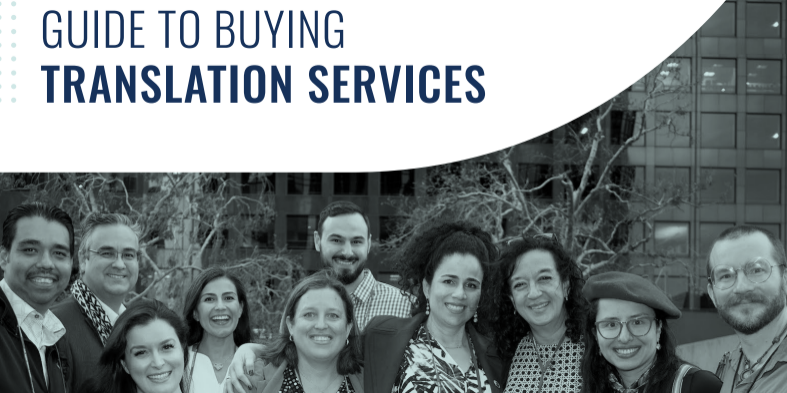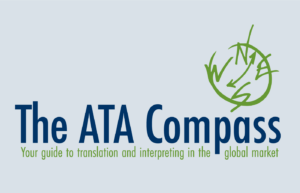Guide to Buying Translation Services, Part IV: Terms to Know

This is the fourth article in a series of articles introducing the American Translators Association’s Guide to Buying Translations Services, which was created to help those in need of translation services find the best provider for their project and work efficiently with the chosen translation provider. For the full guide, click here.
Terms to Know When you Hire a Translation Provider
Translation: converting written text from one language into another
Interpreting: converting speech from one language into another
ATA-certified translator: An individual who has passed the American Translators Association certification exam. This is a professional exam assessing a person’s translation skills, including comprehension, translation technique and writing ability.
Computer-assisted translation: Abbreviated as CAT, this is the use of computer software to increase a human translator’s productivity and consistency. This is different from machine translation.
Editing/Revision: Part of the translation process that involves comparing original and translated documents and making corrections after the translation stage. This step is to ensure accuracy and readability.
Language pair: The combination of a source and target language in relation to the translation process. Examples of language pairs are English to Spanish or Spanish to English. A translator may work or become certified in more than one language pair.
Localization: The process of adapting an entire product or set of content to a specific location in the world or global market through translation and cultural adaptation. Localization is most frequently applied to software, online content and multimedia.
Machine translation: MT refers to using computer technology to automatically translate text from one language to another. Some types of MT use artificial intelligence. Human review is often involved at the final stage of this process. A translation provider can advise on the feasibility of using MT for a specific project.
Proofreading: Part of the translation process that involves checking for typographical, grammatical, structural and spelling errors. This often occurs at the end of the translation workflow as a final quality check.
Source language: The language from which a text is translated.
Subtitling: Providing a written, on-screen version of spoken dialogue in a film or video, translated into various target languages.
Target audience: The public for whom translated text is intended.
Target language: The language into which a text is translated.
Transcreation: The process of creatively adapting a message’s intended meaning from one language to another and creating brand new messaging that is culturally appropriate.
Transcreation is often used for literary, marketing and advertising content.
Transcription: The process of converting audio into written text. Within a translation context, audio or video files may be transcribed in order to then translate their content into another language.
Translation memory: A bilingual database containing previously translated content. It helps ensure consistency across phrases, documents and future projects. The translation memory, or TM, is usually maintained by the service provider.
Working languages: Translators may speak or read many languages, but working languages are the ones they use in their professional practice.
About ATA
Founded in 1959, the American Translators Association (ATA) is the largest professional association of translators and interpreters in the world with members in all 50 states and over 100 countries.
Translation and interpreting foster successful communication across the globe. ATA provides industry insights on the translation and interpreting professions. We are here to help you find the right professional to get your message across.
Additional ATA Resources
About the Authors
Eve Bodeux is an ATA-certified French to English translator specialized in tech marketing, commercial communications, marketing research and official documents. She is the Secretary of the American Translators Association and serves on the ATA Public Relations Committee.
Jamie Hartz is an ATA-certified Spanish to English translator and transcriber specialized in legal and commercial translations. She currently serves as the Chair of the ATA Public Relations Committee.
Language Services Directory
Subscribe to The ATA Compass
Connect with The ATA Compass
Recent Posts
Machine Translation
What is machine translation? Machine translation (MT) is the use of automated software that translates text without human involvement. Adaptive MT is a technology that learns and adjusts in real-time…
Read MoreWhat is a Certified Translation?
What are the basics of a certified translation? In the United States, anyone can certify a translation. A translator does not need to be certified in order to provide a…
Read MoreThe ATA Compass
Want to reach more customers, grow your business, and improve your bottom line? The ATA Compass publishes articles and provides resources to show you how language professionals can help you…
Read MoreWhy Should I Hire a Professional?
It takes more than just the ability to understand two languages. Professional translators and interpreters have the education, experience, and expertise to understand the nuances in one language and transfer…
Read MoreTranslator vs. Interpreter
Watch a Day in the Life of Translators and Interpreters See how translators and interpreters work in this short animated video. Translators do the writing Translators work with the written…
Read MoreBuying Language Services
Guide to Buying Translation Services Translators help power the global economy, working with businesses, governments, non-profits and individuals. Translators work with the written word. The ATA Guide to Buying Translation…
Read More






